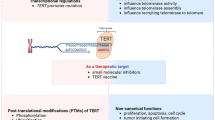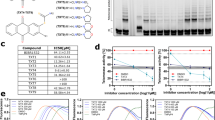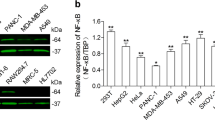Abstract
Human telomerase RNA (hTR) and human telomerase reverse transcriptase (hTERT) are considered effective molecular targets for current anticancer therapy. In this study, we investigated the therapeutic effects of targeting hTR and hTERT individually or in combination by recombinant adenovirus-delivered small interfering RNA (siRNA) in oral squamous cell carcinoma (OSCC) Tca8113. Further, we screened the optimal strategy for RNA interference. Our results show that these different recombinant adenoviruses specifically reduced the levels of hTR mRNA, hTERT mRNA, hTERT protein and telomerase activity in Tca8113 cells. Moreover, they successfully inhibited xenograft tumor growth in nude mice. The potency of their antitumor activities was ranked as follows: anti-hTR >anti-hTR+anti-hTERT >anti-hTERT. Therefore, we demonstrated that the siRNA-expressing recombinant adenoviruses were an effective anticancer tool for treatment of OSCC. Furthermore, the anticancer effect of solely targeting hTR was more direct and efficient, compared with the effect of targeting hTR and hTERT in combination, or hTERT exclusively. The mechanism of this anticancer effect in OSCC was not only related to the inhibition of cell proliferation and the induction of cell apoptosis, but might also involve the inhibition of tumor angiogenesis.
This is a preview of subscription content, access via your institution
Access options
Subscribe to this journal
Receive 12 print issues and online access
$259.00 per year
only $21.58 per issue
Buy this article
- Purchase on Springer Link
- Instant access to full article PDF
Prices may be subject to local taxes which are calculated during checkout




Similar content being viewed by others
Accession codes
References
Fujita H, Nagata M, Hoshina H, Nagashima K, Seki Y, Tanaka K et al. Clinical significance and usefulness of quantification of telomerase activity in oral malignant and nonmalignant lesion. Int J Oral Maxillofac Surg 2004; 33: 693–699.
Venteicher AS, Meng Z, Mason PJ, Veenstra TD, Artandi SE . Identification of ATPases pontin and reptin as telomerase components essential for holoenzyme assembly. Cell 2008; 132: 945–957.
Chen HP, Li YY, Tollefsbol TO . Strategies targeting telomerase inhibition. Mol Biotechnol 2009; 41: 194–199.
Castanotto D, Rossi JJ . The promises and pitfalls of RNA-interference-based therapeutics. Nature 2009; 457: 426–433.
Gupta S, Schoer RA, Egan JE, Hannon GJ, Mittal V . Inducible, reversible, and stable RNA interference in mammalian cells. Proc Natl Acad Sci USA 2004; 101: 1927–1932.
Chen Y, Chen H, Hoffmann A, Cool DR, Diz DI, Chappell MC et al. Adenovirus-mediated small-interference RNA for in vivo silencing of angiotensin AT1a receptors in mouse brain. Hypertension 2006; 47: 230–237.
Yi R, Qin Y, Macara IG, Cullen BR . Exportin-5 mediates the nuclear export of pre-microRNAs and short hairpin RNAs. Genes Dev 2003; 17: 3011–3016.
Li Y, Yao G, Li MY, Li W, Wang F, Jiang Z et al. Inhibition of telomerase RNA (hTR) in cervical cancer by Adenovirus-delivered siRNA. Cancer Gene Ther 2007; 14: 748–755.
Ter Brake O, Konstantinova P, Ceylan M, Berkhout B . Silencing of HIV-1 with RNA interference:a multiple shRNA approach. Mol Ther 2006; 14: 883–892.
Tomlinson RL, Abreu EB, Ziegler T, Ly H, Counter CM, Terns RM et al. Telomerase reverse transcriptase is required for the localization of telomerase RNA to cajal bodies and telomeres in human cancer cells. Mol Biol Cell 2008; 19: 3793–3800.
Chalk AM, Warfinge RE, Georgii-Hemming P, Sonnhammer EL . siRNAdb: a database of siRNA sequences. Nucleic Acids Res 2005; 33 (Database issue): D131–D134.
Jerry W Shay . Telomerase therapeutics: telomeres recognized as a DNA damage signal: commentary re: K. Kraemer et al., antisense-mediated hTERT inhibition specifically reduces the growth of human bladder cancer cells. Clin Cancer Res 2003; 9: 3521–3525.
Kocki J, Kolano J, Cioch M, Dmoszyñska A, Wojcierowski J . The activity of human telomerase in the cells of acute leukaemias. Folia Morphol (Warsz) 2004; 63: 127–128.
Natarajan S, Chen Z, Wancewicz EV, Monia BP, Corey DR . Telomerase reverse transcriptase (hTERT) mRNA and telomerase RNA (hTR) as targets for downregulation of telomerase activity. Oligonucleotides 2004; 14: 263–273.
Hwa Kim S, Hoon Jeong J, Chul Cho K, Wan Kim S, Gwan Park T . Target-specific gene silencing by siRNA plasmid DNA complexed with folate-modified poly (ethylenimine). J Control Release 2005; 104: 223–232.
Venteicher AS, Abreu EB, Meng Z, McCann KE, Terns RM, Veenstra TD et al. A human telomerase holoenzyme protein required for Cajal body localization and telomere synthesis. Science 2009; 323: 644–648.
Yu XM, Lo CY, Chan WF, Lam KY, Leung P, Luk JM . Increased expression of vascular endothelial growth factor C in papillary thyroid carcinoma correlates with cervical lymph node metastases. Clin Cancer Res 2005; 11: 8063–8069.
Maida Y, Yasukawa M, Furuuchi M, Lassmann T, Possemato R, Okamoto N et al. An RNA-dependent RNA polymerase formed by TERT and the RMRP RNA. Nature 2009; 461: 230–235.
Hayashidani E, Hiyama Y, Murakami Y, Sueda T . Attenuation of telomerase activity by hammerhead ribozymes targeting human telomerase RNA and telomerase reverse transcriptase in pancreatic carcinoma cells. Hiroshima J Med Sci 2005; 54: 21–27.
Bain JR, Schisler JC, Takeuchi K, Newgard CB, Becker TC . An adenovirus vector for efficient RNA interference–mediated suppression of target genes in insulinoma cells and pancreatic islets of langerhans. Diabetes 2004; 53: 2190–2194.
Folini M, Brambilla C, Villa R, Gandellini P, Vignati S, Paduano F et al. Antisense oligonucleotide-mediated inhibition of hTERT, but not hTERC, induces rapid cell growth decline and apoptosis in the absence of telomere shortening in human prostate cancer cells. Eur J Cancer 2005; 41: 624–634.
Hao ZM, Luo JY, Cheng J, Li L, He D, Wang QY et al. Intensive inhibition of hTERT expression by a ribozyme induces rapid apoptosis of cancer cells through a telomere length-independent pathway. Cancer Biol Ther 2005; 4: 1098–1103.
Yu XM, Lo CY, Chan WF, Lam KY, Leung P, Luk JM . Increased expression of vascular endothelial growth factor C in papillary thyroid carcinoma correlates with cervical lymph node metastases. Clin Cancer Res 2005; 11: 8063–8069.
Zhou L, Zheng D, Wang M, Cong YS . Telomerase reverse transcriptase activates the expression of vascular endothelial growth factor independent of telomerase activity. Biochem Biophys Res Commun 2009; 386: 739–743.
Güngör R . Telomerase inhibitor GRN163L as a potential antiangiogenic agent for neovascular eye diseases. Invest Ophthalmol Vis Sci 2009; 50: 52.
Kirkpatrick KL, Newbold RF, Mokbel K . The mRNA expression of hTERT in human breast carcinomas correlates with VEGF expression. J Carcinog 2004; 3: 1–9.
Bermudez Y, Yang H, Saunders BO, Cheng JQ, Nicosia SV, Kruk PA . VEGF and LPA-induced telomerase in human ovarian cancer cells is Sp1-dependent. Gynecol Oncol 2007; 106: 526–537.
Acknowledgements
We are thankful for financial support from the National Natural Science Foundation (30901689) of China and Youth Foundation (07025) of Sichuan University Chengdu, China.
Author information
Authors and Affiliations
Corresponding author
Ethics declarations
Competing interests
The authors declare no conflict of interest.
Rights and permissions
About this article
Cite this article
Li, Y., Li, M., Yao, G. et al. Telomerase inhibition strategies by siRNAs against either hTR or hTERT in oral squamous cell carcinoma. Cancer Gene Ther 18, 318–325 (2011). https://doi.org/10.1038/cgt.2010.81
Received:
Revised:
Accepted:
Published:
Issue Date:
DOI: https://doi.org/10.1038/cgt.2010.81
Keywords
This article is cited by
-
Telomerase gene therapy: a remission toward cancer
Medical Oncology (2022)
-
Non-canonical roles of canonical telomere binding proteins in cancers
Cellular and Molecular Life Sciences (2021)
-
shRNA-mediated silencing of hTERT suppresses proliferation and promotes apoptosis in osteosarcoma cells
Cancer Gene Therapy (2017)



